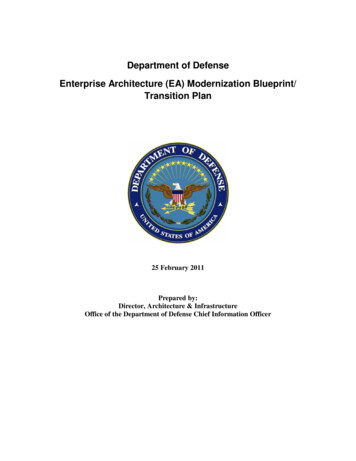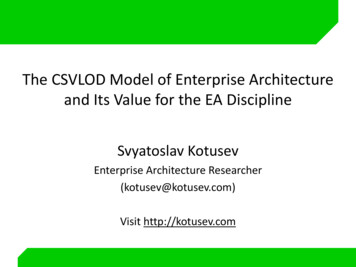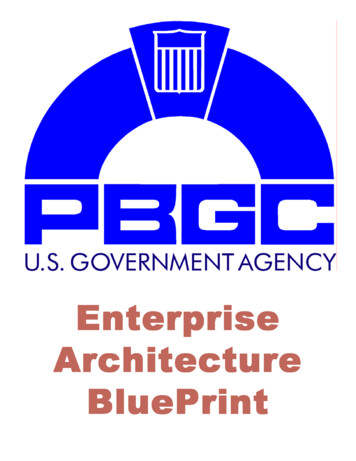
Transcription
Department of DefenseEnterprise Architecture (EA) Modernization Blueprint/Transition Plan25 February 2011Prepared by:Director, Architecture & InfrastructureOffice of the Department of Defense Chief Information Officer
(This Page Intentionally Left Blank)
DoD EA ModernizationBlueprint/Transition PlanExecutive SummaryThe OMB Chief Architect requested a description of the current Enterprise Architecture (EA)Modernization Blueprint/Transition Plan for each agency to further his understanding of thestatus of each agency’s overall EA planning. This document describes the Department ofDefense (DoD) EA, the current status, and the way ahead.The DoD is a complex organization comprised of multiple Components (Combatant Commands,Services, and Agencies) with varying missions and operations. These Components function bothautonomously and as interoperable, integrated elements. A single, monolithic DoD EA cannoteffectively describe all DoD components; current and future capabilities, functions, andrelationships; and the varying transition strategies. It was necessary to take an approach for theDoD EA that provides an effective description of all DoD Components and relates them in somemeaningful way.DoD has taken a federated approach for developing and managing the DoD EA that is based onenterprise-level guidance, capability areas, and component architectures. A Federated DoD EA isthe best way to effectively describe a complex Department and provide the necessary context andguidance to govern, manage, and accomplish the missions of the Department. This approach isdescribed in a Federation Strategy that is currently being updated. The strategy describes anapproach to enterprise architecture that facilitates interoperability and information sharingbetween semi-autonomous departments, components and programs. This approach recognizesthe need for autonomy but requires linkages and alignment of architectures from the Programlevel up to the Enterprise level. A governance body and associated processes are in place toprovide the necessary governance and oversight with respect to the strategy. The Governancebody consists of subordinate working groups that contain Department-wide representation.Requirements for DoD EA compliance are captured in the CIO approved DoD InformationEnterprise Architecture (IEA) document that is posted on the CIO public site for departmentwide use.DoD has instituted a policy requiring the registration of architectures in a DoD architectureregistry system (DARS) that provides visibility and accessibility for all registered architectures.Other architecture requirements are imbedded in various policies in the Department such as theDoDD/I 4630, DoDD 8000, CJCSI/M 3170, and CJCSI 6212. Together, these policies providethe direction needed to maximize the sharing and use of architectures in key DoD processes.ES-1
The federated approach and structure for the DoD EA is constant while the content of the DoDEA continues to change. As new architectures are approved and existing architectures areupdated, the content of the DoD EA grows and matures. DoD has designated eighteen segments,aligned with the Joint Capability Areas (JCA), to guide and support IT investments and solutionsin adherence with OMB guidance. The DoD EA is applied to guide investment portfoliostrategies and decisions; define capability and interoperability requirements; establish andenforce standards; guide security and information assurance requirements across DoD; andprovide a sound basis for transitioning from the existing environment to the futureES-2
ContentsExecutive Summary. ES-11 DoD EA Description.12 Importance of Rules and Context for Applying EA .43 An EA Guided Enterprise.44 Using EA to Improve DoD Performance .65 Applying EA to Improve Governance throughout DoD.75.1 Guidance and Direction Development .75.2 Using EA to Drive Implementation .86 Portfolio-based Investment Management Progress .87 DoD EA Segment .98 Transition Planning in the DoD.98.1 How the DoD EA Guides Transition Planning.108.2 Transition Planning for Core Mission Segments of the Target DoD EA.108.3 Transition Planning for the Business Services Segments of the Target DoD EA .118.4 Transition Planning for the Enterprise Services Segments of the Target DoD EA .118.4.1 DoD IEA .118.4.2 DoD Information Enterprise Strategic Plan and Roadmap.129 Tools for Developing, Implementing, and Managing the DoD EA.139.1 DoD Architecture Framework (DoDAF) .139.2 DoD Architecture Registry System (DARS) .149.3 DoD Information Technology Standards Registry (DISR) .1410 Way Ahead for the DoD EA.1410.1 Federation Strategy Update .1410.2 ASRG Governance Process Refinement .1410.3 Development of the IEOA.1510.4 Enterprise-wide Reference Architecture .1511 Ongoing Architecture-Based Efforts .1511.1 IT Consolidation Strategy and Roadmap (ITCSR) .1511.2 Enterprise-wide Access to Networks and Collaboration Services (EANCS) ReferenceArchitecture (RA) .16i
11.3 IT Infrastructure Optimization Reference Architecture (ITIORA).1611.4 Active Directory Optimization Reference Architecture (ADORA).1712 Key Artifacts Associated with the DoD EA.17ii
1 DoD EA DescriptionAs required by OMB Circulars A-11 and A-130, DoD maintains a target EA that is dynamic,changing, and expanding. Not a single, overarching artifact, the Target EA is a federation ofarchitecture descriptions that provides context and rules for accomplishing the mission of theDepartment. Constituent architectures are developed and maintained at the Department,capability area, and Component levels to collectively define the people, processes, andtechnology required in the current and target environments. Each of the “subsidiary”architectures also provides a roadmap for transitioning a given part of DoD to a new-andimproved, target operating environment.The DoD Enterprise Architecture (EA), depicted in Figure 1, is a continual work in progress. Itexists today as a loosely related set of functionally and organizationally-specific architectures.EA looks at specific functions and capabilities, indicates what policies apply, and providesinterpretation, highlighting the applicable policies and removing ambiguity through operationalcontext. The DoD EA enables decision makers to look across the enterprise for gaps andopportunities for consolidation. The DoD EA will continue to be used to institutionalizeconsistent, effective use of architecture across the Department, strengthen the use of architecturein the key decision-making processes of the Department, including the Joint CapabilitiesIntegration and Development System (JCIDS), Defense Acquisition System (DAS), BusinessCapability Lifecycle (BCL), Planning, Programming, Budgeting and Execution (PPBE),Capability Portfolio Management (CPM), and Joint Concept Development and Experimentation(JCD&E), in a manner that enables better-informed decisions.The DoD EA itself is a federated system in which the leadership of each capability segment andComponent (e.g., Military Department, Defense Agency, and Combatant Command (COCOM))maintains its own architectural documentation and transition plan, and coordinates with allentities with which it overlaps and shares services and capabilities. Enterprise rules outline howthe parts of the federation interrelate to effect optimal Department-wide performance. Each ofthese individual efforts is a substantial effort in and of itself. There is no plan to turn thisfederated environment into an integrated one in which all architectures and plans are rolled upinto a single “master plan.”Each of the various capability and Component transition plans arevery dynamic, with widely ranging periodicity depending upon need. Links to artifacts thatcontain this information are provided towards the end of this document.1
Figure 1 - DoD Enterprise Architecture (EA) GraphicThe top of Figure 1 shows the architecture tools, reference models, standards, guidance, and thelaws, regulations, and policies that govern DoD’s operations. These are reflected in the DoD EAas controls of various types on the business processes, business activities, business rules, ITservices, IT standards applied –as well as the information/data handling by everyone –throughout the Department.The middle of Figure 1 shows the nine Joint Capability Areas (JCAs) for the DoD. The JCAs area standardized set of definitions that cover the complete range of the Department’s missionrelated activities. Initially established in 2005 by the Joint Staff with input from each of themilitary services, the set of JCAs was designed to facilitate side-by-side comparisons of servicecontributions to joint mission needs, as decision-makers address the implications of movingresources between service budgets. Other parts of the DoD EA are built and maintained bydifferent stakeholders. The DoD has currently designated eighteen DoD Segments grouped intothe three categories prescribed by OMB (Core Mission-related, Enterprise Services-related, andBusiness Services-related) that align with the JCAs. The DoD Segments are listed in Table 1.DoD Components, shown along the bottom of Figure 1, represent enterprises unto themselves,operating within the scope of the larger DoD enterprise. Each Component has EnterpriseArchitecture (s), which align with that maintained by each of the other Components, to jointlysupport DoD missions.2
Solution Architectures are not part of the DoD EA, but they are shown to theright of the diagram to indicate that solutions are guided and constrained bythe architectures that make up the DoD EA. They play a key role in the DoDacquisition processes in that architecture-enabled solutions facilitate improvedinteroperability, better information sharing, stricter compliance, leaner processes,and result in reduced costs and more effective mission accomplishment. SolutionArchitecture viewpoints provide key components of the Capability DevelopmentDocument (CDD) and Capability Production Document (CPD) to ensure DoDunderstands the linkages between capabilities and systems and can makeappropriate acquisition decisions; and the performance attributes, including keyperformance parameters (KPPs) and key system attributes (KSAs), that define themost critical elements of performance for the systems under development.Table 1 - DoD Designated SegmentsCore Mission SegmentsForce ApplicationBuilding PartnershipsCommand & ControlEnterprise ServicesSegmentsIdentity & InformationAssuranceIT InfrastructureInformation TechnologyManagementBattlespace Awareness-ISRBattlespace AwarenessEnvironmentProtectionBattlespace NetworksForce TrainingForce ManagementHealthBusiness Services SegmentsHuman ResourcesManagementLogistics/Supply Chain MgmtInstallation SupportFinancial ManagementAcquisitionThe DoD IEA is represented in Figure 1 by a vertical block positioned across the nine JCAs. Thecurrent Version 1.2, released in May 2010, provides the foundation for achieving the DoDInformation Enterprise (IE) vision. It describes a set of principles, rules, activities, applicationguidance, and compliance criteria that apply to all DoD architectures. The purpose of the DoDIEA is to: Unify the concepts embedded in the DoD net-centric strategies into a common vision Drive common solutions and promote consistency Describe the integrated Defense Information Enterprise and the rules for informationassets and resources that enable it Foster alignment of DoD architectures with the enterprise net-centric vision3
A key addition to the DoD IEA v1.2 is an appendix (Appendix G) that describes the compliancerequirements for the DoD EA. They are: Compliance with the DoD IEA Architecture Registration Requirements: DTM 09-013 mandates registration ofarchitectures in DARS Compliance with Capability and Component EAs Compliance with DISR: All architectures must incorporate applicable standards from theDISR Compliance with Mandatory Core Designated DoD Enterprise Services (ES): DoD ESmandated for use by all programs and initiatives Use of Shared designated DoD ES: To be used by programs and initiatives to the greatestextent feasibleTogether, these parts comprise the federation known as the DoD EA. Each part of the DoD EArepresents a strategic, capability or component scope. Federation enables the distributeddevelopment and maintenance of the many parts.2 Importance of Rules and Context for Applying EAThe intended use of the DoD EA is to guide investment portfolio strategies and decisions, definecapability and interoperability requirements, establish and enforce standards, guide security andinformation assurance requirements across DoD, and provide a sound basis for transition fromthe existing environment to the future. The EA communicates a vision of how the DoDenterprise operates at differing levels of abstraction, by documenting both rules for managing theenterprise and a context within which to apply them: Rules: The laws, regulations, policies, strategies, principles, guidance and standards(technical, data, business, mission, etc.) that apply to various parts of the enterprise Context: The depictions of relationships (such as hierarchies, processes, informationflows, interfaces, syntax, and dependencies) that show how the enterprise guidanceapplies to each mission and functionRules enable our distributed organization to function as a single enterprise and move (in unison)toward a common target vision. Context adds clarity and relevance to the rules.3 An EA Guided EnterpriseThough EA was mandated in law, regulation, and policy to support enterprise IT decisions, DoDhas learned that EA can be leveraged to support a vast array of functions ranging from processimprovement to organizational restructuring to mission performance enhancement. TheDepartment’s approach to applying architecture is to not have an enterprise that’s driven by EA,4
but rather to use EA to guide the Department’s performance improvement strategy –i.e., to helpmake the operational processes, infrastructure, and materiel solutions of the DoD better. Theseimprovements should also serve to maximize net-centric data sharing and service exposure,discovery and use. The resulting solutions should help achieve improved interoperability, betterinformation sharing, tighter compliance, leaner processes, reduced costs, and more effectivemission accomplishment. Developing EA to guide the Department’s Performance Improvementrelies heavily on three instances of enterprise architecture: Strategic Architectures are a set of descriptions focused on the rules and principles thatapply to all investments regardless of capability, Component or portfolio. Thesearchitectures contain rules and principles that apply to all investments regardless ofcapability, Component or portfolio. The DoD IEA is a prime example of this type ofarchitecture. It includes rules about how information generated in operations across DoDshould be made visible, accessible, and understandable, in a trusted environment for allauthorized users, across the Department. Programs must align to this guidance to befunded. Moreover, the DoD IEA contains the information sharing rules applicable to allprograms to make information sharing integral to everything the Department does.Because they are so cross-cutting, these types of rules belong in this type of strategicarchitecture rather than in a modular capability segment. Capability Architectures are set of descriptions focused on portraying the context andrules required to achieve a desired effect through a combination of doctrine, organization,training, materiel, leadership and education, personnel, and facilities (DOTMLPF). TheBusiness Enterprise Architecture (BEA) today is a good example of a collection ofcapability segment architectures covering Finance, Human Resources, Acquisition, andother business domains. Mission Thread Architectures are a set of descriptions focused on describing the processand information flow required to achieve a mission or effect using the full range ofrequired capabilities. A Mission Thread Architecture provides the warfighter’s viewpointby weaving other portions of the DoD Enterprise Architecture together with missionunique elements. Typically, these architectures focus on process maps that link enterprisecapabilities. This is an area that takes full advantage of the intersection between EASegments and JCAs.Each of these types of architecture is essential to the proper functioning of the Department.Working together, they ensure that there is sufficient guidance not only to perform specificcapabilities in isolation, but also to ensure that interoperable information flows consistentlyacross capability areas and segments, demonstrating that architected capabilities can beeffectively engaged and integrated to achieve the mission objectives of the Department.5
4 Using EA to Improve DoD PerformanceThe strategy for using architectures to guide performance improvement in the Departmentembodies four key elements: Define, develop and maintain (segmented) enterprise architecture. The Departmentmaintains the DoD EA at the DoD Enterprise level and at the Component level, whileensuring that the overarching structure for federating architectures align to DoD’sportfolio structure. The DoD architecture is used to ensure that investments are properlyassessed in a Federal-wide context by aligning all information technology investmentswith the Federal Enterprise Architecture (FEA) Reference Models and the FederalTransition Framework (FTF). Define, develop and maintain solution architectures. The Department develops andmaintains solution architectures for material and non-material initiatives and capabilitiesthat deliver functionality for the DoD information enterprise, ensuring that both thesolution architectures and solutions themselves conform with the DoD EA. Use DoD architecture information for better-informed decisions. The Department hasbeen using the DoD EA to guide investment portfolio strategies and decisions, definecapability and interoperability requirements, establish and enforce standards, guidesecurity and information assurance requirements across the Department of Defense andprovide a sound basis for transition from the existing environment to the future. DoD EAis also used to guide solution architectures to clearly articulate requirements, influencedesign and implementation, and demonstrate interoperability. DoD EA is also being usedto review all IT investments, including those related to National Security Systems, forcompliance with the DoD EA and applicable approved solution architectures. DoDarchitecture is used to institutionalize consistent, effective use of architecture across theDepartment, strengthen the use of architecture in the key decision making processes ofthe Department, including the Joint Capabilities Integration and Development System(JCIDS), Defense Acquisition System (DAS), Business Capability Lifecycle (BCL),Planning, Programming, Budgeting and Execution (PPBE), Capability PortfolioManagement (CPM), and Joint Concept Development and Experimentation (JCD&E), ina manner that enables better-informed decisions. Govern the DoD-EA. The Department governs architectures through formal processesconsistent with the organizational and functional structure of the Department.Architectures will be registered and approved through the formal governance processes.As part of the governance process, DoD will continue to sustain and apply standards fordocumenting architecture content to promote reuse, common vocabulary and integration.6
5 Applying EA to Improve Governance throughout DoDThe Department conducts periodic assessments of architecture management maturity and thecontributions of architecture to mission effectiveness, efficiency, information sharing, andtransparency. The Office of the DoD CIO has reorganized the governance structure to betteralign with emerging policy.The Architecture and Standards Review Group (ASRG) is the primary governance bodyresponsible for architectures and standards. The ASRG has DoD-wide membership and isresponsible for recommending approval of architectures for inclusion in the architecturefederation or DoD Enterprise Architecture and approval of IT standards for inclusion in theDISR. The ASRG along with two other review groups, the Enterprise Services Review Group(ESRG) and Information Assurance Enterprise Review Group (IAERG) perform governancefunctions as part of a larger Enterprise Governance Board (EGB).5.1 Guidance and Direction DevelopmentOne EGB objective is to develop and approve DoD CIO enterprise-wide guidance (includingarchitecture, standards and policies) to determine effectiveness and deficiencies, with resultingcourses of action, in satisfying DoD mission needs by: Guiding the development of the DoD Enterprise Architecture (DoD EA), related policiesand standards. Approving enterprise information architectures, policies and standards to guide andsupport the management of DoD IT within the Planning, Programming, Budgeting, andExecution (PPBE) (including Capability Portfolio Management [CPM] and CapitalPlanning and Investment Control [CPIC]), Joint Capabilities Integration andDevelopment System (JCIDS) and Defense Acquisition System (DAS) processes. Approving enterprise-wide guidance and tool requirements to support the analysis andmanagement of IT across the Department by Component CIOs, Component AcquisitionExecutives (CAEs), IT Portfolio Management (IT PfM) Mission Area Leads and DoDCPM Co-Leads. Tasking tiger teams to research specific issues related to enterprise architecture and ITimplementation strategies in a collaborative, transparent and objective manner. Use tigerteam reports to help frame enterprise guidance. Assessing the technical, operational and financial cost and benefits of potential enterpriseservices, providing a process by which potential enterprise services can be reviewed andapproved for designation as Mandatory Core DoD Enterprise Services and/or SharedDoD Enterprise Services.7
5.2 Using EA to Drive ImplementationAnother EGB objective is to drive implementation of, and ensure compliance of all ITinvestments with DoD EA related policies and standards by: Tasking Components to develop implementation plans for Mandatory Core DesignatedDoD Enterprise Services and Shared Designated DoD Enterprise Services, and conductfollow-up reviews on an annual basis to ensure Components comply with their ownimplementation plans. Validating and modifying the review and waiver processes as required to ensurecompliance of all IT with applicable portions of the DoD EA. Convening as the DoD CIO Investment Review Board (IRB) to review, approve, andoversee the planning, design, acquisition, deployment, operation, maintenance, andmodernization of defense business systems the primary purpose of which is to supportinformation technology infrastructure or information assurance activities, and as directedby the Secretary of Defense.Another aspect of the DoD IT governance process is portfolio management which includes theIT investment prioritization process. The DoD Components are responsible for funding the ITinitiatives supporting their respective portions of collaborative, joint programs. Therefore, theportfolio management process must be coordinated in a Department-wide effort in order to focuson the mission of the Department –i.e., Warfighting.6 Portfolio-based Investment Management ProgressSince 2005, a Four Mission Area construct (i.e., Warfighting, Business, Intelligence, andEnterprise Information Environment) had been used as an IT portfolio management and EAconstruct in accordance with DoD Directive 8115.01 (IT Portfolio Management). Thosedesignations were purposefully broad to provide a base level of alignment and accountability formanaging the Department’s IT portfolio. As portfolio management became more valued overtime, the DoD moved toward managing all of its investments—not just IT— via portfolios.Whereas the Quadrennial Defense Review of 2005 initiated the Capability PortfolioManagement (CPM) process with pilots, the recently signed Capability Portfolio ManagementDirective (DoD Directive 7045.01) prescribes a structure whereby all DoD programs are to bemanaged in a suite of portfolios. The content of the overall portfolios continues to evolve, theidea that all DoD investments will be managed as portfolios is established.The DoD Chief Information Officer (CIO) is now aligning IT Portfolio management as part ofthe Department’s overall portfolio processes –not as a separate, discrete process. In today’sworld it is impossible to separate core processes from the information flows that support them.Thus, it is logical that IT Portfolio Management (PfM) be a portion of the overall PfM8
responsibilities of process owners and organizations across the Department. Consequently,within DoD it is the responsibility of the core process owners and Components to developarchitectural content to support their respective areas. The DoD CIO is realigning IT PfM andEA policy with this position. DoD CIO involvement is focused on: Providing frameworks as tools to support DoD EA development and use to support ITPfM Participating in portfolio management activities across DoD.Within the CPM construct described above, Segment Architectures as defined by OMB areequivalent in the DoD EA to Capability Architectures -- sets of descriptions focused onportraying the context and rules required to achieve a desired effect through a combination ofdoctrine, organization, training, materiel, leadership and education, personnel, and facilities(DOTMLPF). Capability architectures (enable the Department to inform and guide ITinvestments, identify potential gaps and overlaps and understand the broader operationalconstructs and segment interrelationships. The Business Enterprise Architecture (BEA) today is agood example of a capability architecture that spans multiple segments including FinancialManagement, Human Resources Management, Acquisition, and others.7 DoD EA SegmentIn response to the evolution of DoD’s portfolio management and EA efforts, we have identified amore granular set of EA segments (see Table 1 above). Further, these EA segments are alignedwith the JCA overarching Departmental portfolio management construct. As the Department’sportfolio management construct matures, the identification of additional EA segments isexpected to evolve over time and be incorporated into that construct.While the DoD EA spans both the DoD Enterprise level and the Component level, the segmentarchitectures exist primarily at the DoD Enterprise level –thereby providing consistent guidancethat applies to all programs, initiatives and capabilities within the Department of Defense.Component architectures extend the enterprise-level guidance, providing additional componentspecific information that applies to all solutions within their organization. As Enterprisesegments solidify, component architectures will begin to align to them specifically (as is alreadythe case where component EAs align with the BEA).8 Transition Planning in the DoDThe Secretary of Defense sets the strategy, provides oversight, and manages capabilityintegration across all DoD Components. Recognizing that each Component has its own way ofdoing business, its own constituencies and its own appropriations, it is essential that Components9
maintain responsibility for executing their assigned missions, conducting joint operations andensuring information flows freely across the enterprise.The Department’s approach to net-centric transformation in this environment is guided by theconcepts of Tiered Accountability and Federat
Figure 1 - DoD Enterprise Architecture (EA) Graphic The top of Figure 1 shows the architecture tools, reference models, standards, guidance, and the laws, regulations, and policies that govern DoD's operations. These are reflected in the DoD EA as controls of various types on the business processes, business activities, business rules, IT











